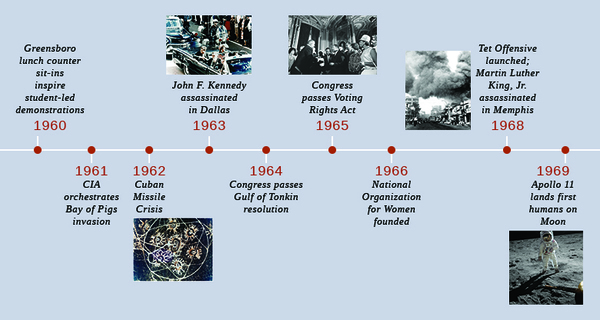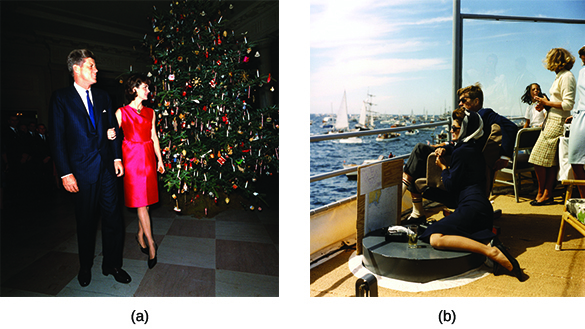| << Chapter < Page | Chapter >> Page > |

In the 1950s, President Dwight D. Eisenhower presided over a United States that prized conformity over change. Although change naturally occurred, as it does in every era, it was slow and greeted warily. By the 1960s, however, the pace of change had quickened and its scope broadened, as restive and energetic waves of World War II veterans and baby boomers of both sexes and all ethnicities began to make their influence felt politically, economically, and culturally. No one symbolized the hopes and energies of the new decade more than John Fitzgerald Kennedy, the nation’s new, young, and seemingly healthful, president. Kennedy had emphasized the country’s aspirations and challenges as a “new frontier” when accepting his party’s nomination at the Democratic National Convention in Los Angeles, California.
The son of Joseph P. Kennedy, a wealthy Boston business owner and former ambassador to Great Britain, John F. Kennedy graduated from Harvard University and went on to serve in the U.S. House of Representatives in 1946. Even though he was young and inexperienced, his reputation as a war hero who had saved the crew of his PT boat after it was destroyed by the Japanese helped him to win election over more seasoned candidates, as did his father’s fortune. In 1952, he was elected to the U.S. Senate for the first of two terms. For many, including Arthur M. Schlesinger, Jr., a historian and member of Kennedy’s administration, Kennedy represented a bright, shining future in which the United States would lead the way in solving the most daunting problems facing the world.
Kennedy’s popular reputation as a great politician undoubtedly owes much to the style and attitude he personified. He and his wife Jacqueline conveyed a sense of optimism and youthfulness. “Jackie” was an elegant first lady who wore designer dresses, served French food in the White House, and invited classical musicians to entertain at state functions. “Jack” Kennedy, or JFK, went sailing off the coast of his family’s Cape Cod estate and socialized with celebrities ( [link] ). Few knew that behind Kennedy’s healthful and sporty image was a gravely ill man whose wartime injuries caused him daily agony.

Nowhere was Kennedy’s style more evident than in the first televised presidential debate held on September 23, 1960, between him and his Republican opponent Vice President Richard M. Nixon. Seventy million viewers watched the debate on television; millions more heard it on the radio. Radio listeners judged Nixon the winner, whereas those who watched the debate on television believed the more telegenic Kennedy made the better showing.
View television footage of the first Kennedy-Nixon debate at the JFK Presidential Library and Museum.

Notification Switch
Would you like to follow the 'U.s. history' conversation and receive update notifications?